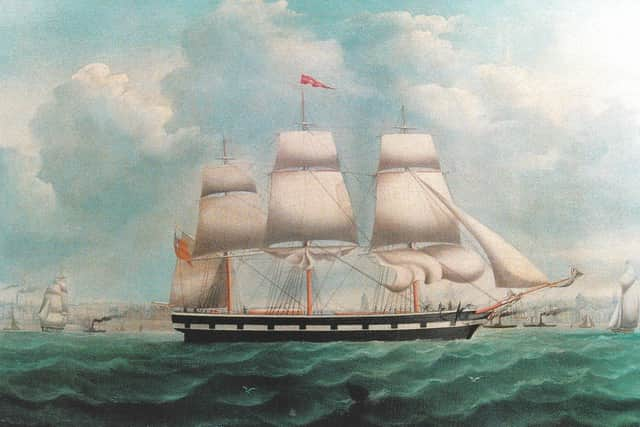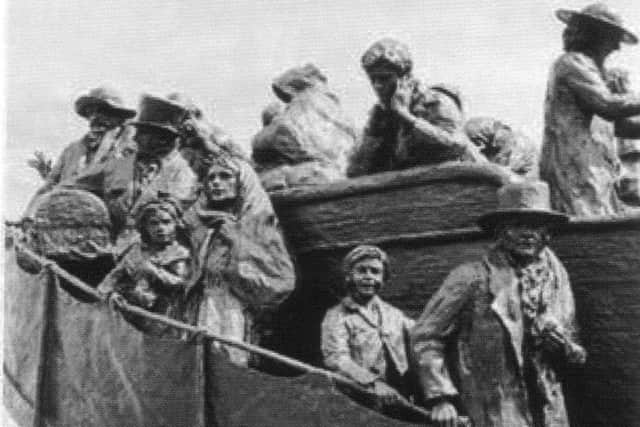Derry to Philadelphia: The Irish Gateway to America
and live on Freeview channel 276
They tended to enter via Philadelphia; of 128 vessels advertised to sail from Derry between 1750 and 1775, 99 of them sailed for Philadelphia.
From Philadelphia they poured across the Susquehanna into the Cumberland Valley. From the 1740s they moved southwards through the Great Valley, east of the Appalachians, across the Potomac and into the Shenandoah Valley.
Advertisement
Hide AdAdvertisement
Hide AdFrom there they continued south into the Piedmont of North and South Carolina. By 1776, about 90% of Ulster settlers had made their homes in Pennsylvania, the Valley of Virginia and the Carolinas.


James Buchanan, of Ramelton, departed from Derry on the Providence on June 4, 1783. James established a trading post at Cove Gap in the Allegheny Mountains, married Elizabeth Spear, and, on April 23, 1791, their son, James Buchanan, who was to become the 15th President of the USA from 1857 to 1861, was born.
Linen and emigration established Derry as one of the chief Irish ports for transatlantic trade. Flaxseed was shipped to Derry from Philadelphia in the early spring, and on the return voyage linen and emigrants were destined for Philadelphia.
Captain Conolly McCausland of Streeve Hill (near Limavady) was assisting mass emigration from the Roe Valley, as commander of ships, Walworth, Jane and Faithful Steward during the revolutionary period, 1768-1785.
Advertisement
Hide AdAdvertisement
Hide Ad

Conolly and his brother Abraham McCausland, merchant of Culmore, were engaged in transatlantic trade together with their cousins Robert McCausland of Coleraine and John Stirling of Walworth.
Conolly McCausland captained the Walworth on a dozen or more voyages between 1768 and 1773. The ship was a joint venture with Strabane-born Thomas Barclay.
Barclay followed his uncle Samuel Carsan, also a Strabane emigrant, to Philadelphia, then the largest port in America. Carsan, joint owner of over 20 ships, built up the Philadelphia mercantile firm of Carsan and Davey.
In the 1760s with Thomas Barclay’s arrival, a new partnership emerged: Carsan, Barclay and Mitchell. The third principal was William Mitchell, the son of James Mitchell of Derry.
Advertisement
Hide AdAdvertisement
Hide AdThere is a tendency to see the Famine of 1846 to 1851, when over a million people left Ireland for North America, as the cause of the Irish Diaspora.
In reality heavy emigration began before the Famine and continued after it. With the end of the Napoleonic Wars in 1815 many small farmers, agricultural labourers and rural tradesmen saw emigration as the only solution to their declining prospects.
Derry’s importance as an emigration port continued to grow in the 19th century. Merchants became ship-owners as opposed to agents for American and British companies.
An outward cargo of emigrants, a homeward cargo of timber or grain, together with two voyages per year, one in spring and one in the autumn, ensured a sizeable profit. Two local companies, J & J Cooke and William McCorkell & Co. dominated transatlantic trade.
Advertisement
Hide AdAdvertisement
Hide AdAt the height of the Famine in 1847, of 12,385 emigrants leaving from Derry for North America, 5,104 or 41% were carried by J & J Cooke in 20 ships; 8 of these ships were destined for Philadelphia, 7 for Saint John, New Brunswick and 5 for Quebec.
In the 1860s the McCorkell Line demonstrated sailing ships could compete with steam. They had five ships plying between Derry and New York and Philadelphia: Mohongo, Minnehaha, Stadacona, Village Belle and Lady Emily Peel.
The McCorkell family commissioned oil paintings of many ships which sailed under the McCorkell flag.
Oil paintings were produced of the Caroline, Erin, Harvester, Hiawatha, Minnehaha, Mohongo, Osseo, Oweenee, Village Belle and Wenonah.
Advertisement
Hide AdAdvertisement
Hide AdThe Song of Hiawatha by Longfellow was a source of inspiration in the naming of many of the ships.
The Mohongo, painted by Francis Hustwick, was built in New Brunswick in 1851, and made over one hundred crossings. She carried passengers from Derry and was known in Quebec, Saint John, New York, Baltimore, New Orleans and Philadelphia.
An examination of sources relating to ‘The Du Pont Company’ at the Hagley Museum and Library, demonstrates that the firm assisted many Irish immigrants.
Du Pont enabled workers at their gunpowder works, established 1802, at Hagley along the banks of the Brandywine in Wilmington, Delaware to arrange the passage of friends and relatives to Philadelphia.
Advertisement
Hide AdAdvertisement
Hide AdAgents for DuPont in Philadelphia included Andrew J. Catherwood from 1847 to 1854 and Robert Taylor from 1830 to 1850. These two men also acted as agents for the two biggest shipowners in Derry; Andrew J Catherwood, from his Philadelphia office at ’62 North Second Street above Arch’, for J & J Cooke; and Robert Taylor for William McCorkell & Co.
Through the paternalism of Du Pont, Derry, in the 1820s and 1830s, became the leading city in Ireland and Britain dealing with pre-paid passages; hence the story of DuPont immigrants is part of the bigger story of Irish immigration and the port of Philadelphia. Indeed, it has been said that ‘the Londonderry to Philadelphia route was the oldest Irish emigrant trade route.’
The Irish Memorial, a national monument at Penn’s Landing, Philadelphia, is ‘dedicated to the memory of more than one million innocent men, women and children who perished during the years 1845 to 1850 and to the millions of Irish immigrants who found here in the USA the freedom, liberty and prosperity denied to their ancestors in Ireland’.
The centrepiece is a monumental bronze sculpture, created by Glenda Goodacre, set in a 1.75 acre dedicated park.
Advertisement
Hide AdAdvertisement
Hide AdIt depicts the cruel starvation which claimed one million Irish lives between 1845 to 1850; the harrowing journey to America taken by a million more; and the indomitable spirit of those who arrived safely and resolved to face the challenges of life in a new world.
Brian Mitchell’s illustrated booklet, Derry~Londonderry: Gateway to a new world can be purchased (£3.00) at the Guildhall or Tower Museum. Contact Brian at [email protected].
